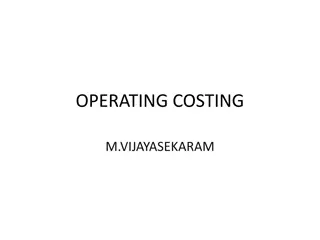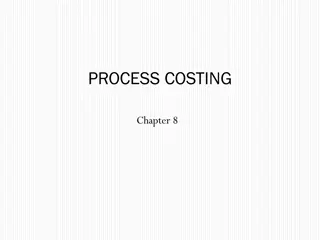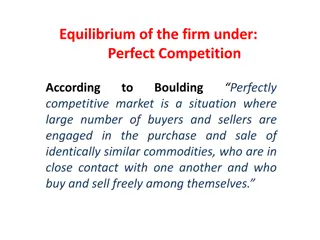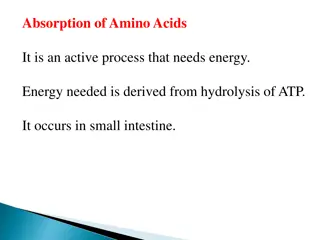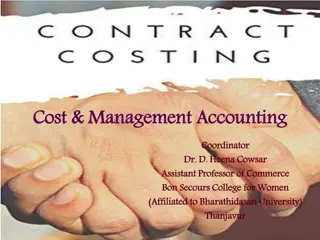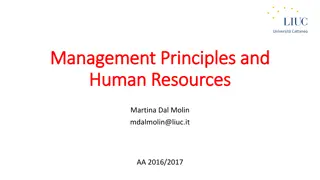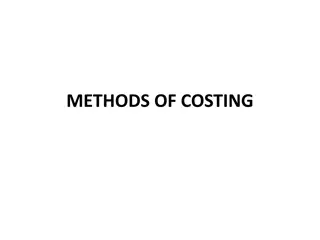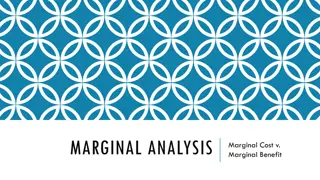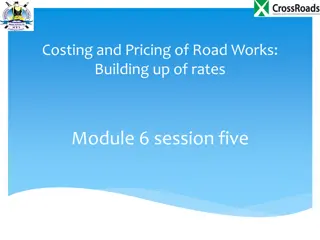Understanding Absorption and Marginal Costing in Accounting
Absorption costing, also known as full costing, encompasses all costs including fixed and variable related to production. It aids in determining income by considering direct costs and fixed factory overheads. Meanwhile, marginal costing focuses on only variable manufacturing costs and treats fixed factory overheads as period costs. Both methods have their own advantages and limitations in cost ascertainment and income determination.
Download Presentation

Please find below an Image/Link to download the presentation.
The content on the website is provided AS IS for your information and personal use only. It may not be sold, licensed, or shared on other websites without obtaining consent from the author. Download presentation by click this link. If you encounter any issues during the download, it is possible that the publisher has removed the file from their server.
E N D
Presentation Transcript
ABSORPTION AND MARGINAL OR VARIABLE COSTING
CHAPTER OBJECTIVES Meaning, definition and characteristics of absorption costing. Determination of income under absorption costing. Advantages and limitations of absorption costing. Meaning, definition and characteristics of marginal costing. Assumptions of marginal costing. Determination of income under marginal costing. Advantages and limitations of marginal costing.
ABSORPTION COSTING Absorption costing also known as full costing is the total cost technique. It is the conventional and most widely used technique of ascertaining cost. CIMA, London, defines absorption costing as the practice of charging all costs both variable and fixed to operations, processes or products. Under this technique, product cost is made up of all direct costs (i.e. direct material, direct labour, direct expenses and variable factory overheads) plus fixed factory overheads absorbed at a predetermined rate on the basis of normal capacity. The administration, selling and distribution overheads are treated as period costs, and hence, are written off against the income for the period in which they are incurred.
CHARACTERISTICS OF ABSORPTION COSTING All variable manufacturing costs and fixed factory overheads are treated as product costs and hence charged to products, processes or operations. All administration, selling and distribution overheads are treated as period costs, and hence are written off against the profits of the period in which they are incurred. As fixed factory overheads are included in unit cost, the value of closing inventory includes fixed factory/production overheads. Under absorption costing, cost per unit remains same only if there is no change in the level of output. However, in case the level of output changes, the cost per unit also changes because of the presence of fixed costs.
ASCERTAINMENT OF INCOME UNDER ABSORPTION COSTING THE INCOME UNDER ABSORPTION COSTING IS DETERMINED AS BELOW : Income Statement Under Absorption Costing ` ` PARTICULARS A. SALES B. DIRECT MATERIAL DIRECT LABOUR DIRECT EXPENSES VARIABLE PRODUCTION/FACTORY OVERHEADS FIXED PRODUCTION OVERHEADS (ACTUAL PRODUCTION PREDETERMINED RATE) ADD : VALUE OF OPENING STOCK LESS : VALUE OF CLOSING STOCK ADD : UNDER-ABSORBED FIXED FACTORY OVERHEADS LESS : OVER-ABSORBED FIXED FACTORY OVERHEADS C. GROSS PROFIT (A B) D. ADMINISTRATION, SELLING AND DISTRIBUTION OVERHEADS : VARIABLE FIXED E. NET INCOME OR PROFIT (C D) COST OF GOODS SOLD :
ADVANTAGES OF ABSORPTION COSTING Absorption costing is a simple and most commonly used technique of ascertaining cost. The technique of absorption costing ensures that all costs including fixed and variable related to production are charged to products, processes or operations. It ensures correct fixation of selling prices in the long run as fixed costs are also considered for calculating per unit cost. The ascertainment of income under absorption costing shows gross profit and net profit separately which helps in taking various decisions. It discloses inefficient and efficient utilization of resources allocated to a particular cost centre by indicating under absorption and overabsorption of fixed production overheads. It conforms to the principles of accrual and matching of costs with revenues of the relevant period.
LIMITATIONS OF ABSORPTION COSTING As the cost per unit changes with the change in the level of output under absorption costing, comparison and control of costs becomes difficult. In absorption costing, some of the current period s fixed costs are carried forward to the next period because of the valuation of closing stock based on cost per unit inclusive of fixed factory overheads. It is not helpful in taking certain managerial decisions such as selection of a profitable product/sales mix; make or buy decisions, accept or reject decisions, additional orders or orders of export; problem of key or limiting factor, determination of the optimum level of activity, close or shut down decisions, etc. The fixed manufacturing overheads may be absorbed on wrong or arbitrary basis causing under or over recovery of overheads. It may not be possible to prepare flexible budgets under absorption costing.
MEANING & DEFINITIONS OF MARGINAL COST According to the Terminology of Cost Accountancy of the Institute of Cost and Management Accountants, London, Marginal Cost represents the amount at any given volume of output by which aggregate costs are changed if the volume of output is increased by one unit . In the words of Blocker and Weltmore, Marginal Cost is the increase or decrease in total cost which results from producing or selling additional or fewer units of a product or from a change in the method of production or distribution such as the use of improved machinery, addition or exclusion of a product or territory, or selection of an additional sales channel.
MARGINAL COSTING The Institute of Cost and Management Accountants, London, has defined Marginal Costing as the ascertainment of marginal costs and of the effect on profit of changes in volume or type of output by differentiating between fixed costs and variable costs . In this technique of costing only variable costs are charged to operations, processes or products, leaving all indirect costs to be written off against profits in the period in which they arise. Thus, in this context, marginal costing is not a system of costing such as process costing, job costing, operating costing, etc. but a technique which is concerned with the changes in costs and profits resulting from changes in the volume of output. Marginal costing is also known as variable costing .
CHARACTERISTICS OF MARGINAL COSTING It is a technique of analysis and presentation of costs which help management in taking many managerial decisions and is not an independent system of costing such as process costing or job costing. All elements of cost production, administration and selling and distribution are classified into variable and fixed components. Even semi-variable costs are analysed into fixed and variable. The variable costs (marginal costs) are regarded as the costs of the products. Fixed costs are treated as period costs and are charged to profit and loss account for the period for which they are incurred. The stocks of finished goods and work-in-process are valued at marginal costs only. Prices are determined on the basis of marginal cost by adding contribution which is the excess of sales or selling price over marginal cost of sales
ASSUMPTIONS OF MARGINAL COSTING All elements of cost production, administration and selling and distribution can be segregated into fixed and variable components. Variable cost remains constant per unit of output irrespective of the level of output and thus fluctuates directly in proportion to changes in the volume of output. The selling price per unit remains unchanged or constant at all levels of activity. Fixed costs remain unchanged or constant for the entire volume of production. The volume of production or output is the only factor which influences the costs.
DETERMINATION OF INCOME UNDER MARGINAL COSTING Income Statement Under Marginal Costing Particulars ` ` A. Sales B. Direct Material Cost Direct Labour Cost Direct Expenses Variable Production/Manufacturing Overheads Variable Cost of Goods Product Add : Opening Stock Variable Cost of Sales : Less : Closing Stock Add : Variable Administration Overheads Add : Variable Selling and Distribution Overheads Variable Cost of Sales Contribution (A B) Fixed Overheads : C. D. Fixed Factory/Production Overheads FixedAdministration Overheads Fixed Selling and Distribution Overheads Profit or Income Under Marginal Costing E.
ADVANTAGES OF MARGINAL COSTING 1. Simple to operate and easy to understand 2. Removes complexities of under-absorption of overheads 3. Helps management in Production Planning. 4. No possibility of fictitious profits by over-valuing stocks 5. Facilitates calculation of important factors like B.E.P. 6. Valuable aid to management for Decision-Making 7. Facilitates study of relative profitability 8. Complimentary to Standard Costing and Budgetary control 9. Helps in Cost Control 10. Profit Planning 11. Management Reporting
LIMITATIONS /DISADVANTAGES OF MARGINAL COSTING The technique of marginal costing is based upon a number of assumptions which may not hold good under all circumstances. All costs are not divisible into fixed and variable. There are certain costs which are semi- variable in nature. it is very difficult and arbitrary to classify these costs into fixed and variable elements. Variable costs do not always remain constant and do not always vary in direct proportion to volume of output because of the laws of diminishing and increasing returns. Selling prices do not remain constant for ever and for all levels of output due to competition, discounts for bulk orders, changes in the general price level, etc. Fixed costs do not remain constant after a certain level of activity. Further, marginal costing ignores the fact that fixed costs are also controllable.





